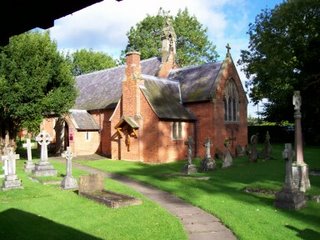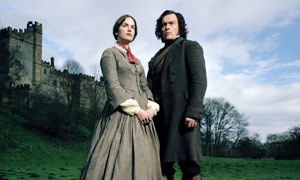
 Yesterday, heavy rain fell for most of the day, leaving large puddles and slicks of mud along the footpath around Kenilworth Castle. But this morning is clear and cool, and feels distinctly autumnal. In the hedges around Kenilworth, the holly berries are turning red. In the borage fields beyond the castle, the bees were swarming. Our "castle walk" this morning took us down Chase Lane and up Beehive Hill, at the end of which stands St. Austin's Roman Catholic Church, the older of the two Catholic churches in town. St. Austin's, built in 1841 (a dozen years after Catholic Emancipation), was designed by the great English Gothic Revival architect Augustus Welby Pugin (1812-1852), who was also responsible for Southwark Cathedral and the interiors of the Houses of Parliament.
Yesterday, heavy rain fell for most of the day, leaving large puddles and slicks of mud along the footpath around Kenilworth Castle. But this morning is clear and cool, and feels distinctly autumnal. In the hedges around Kenilworth, the holly berries are turning red. In the borage fields beyond the castle, the bees were swarming. Our "castle walk" this morning took us down Chase Lane and up Beehive Hill, at the end of which stands St. Austin's Roman Catholic Church, the older of the two Catholic churches in town. St. Austin's, built in 1841 (a dozen years after Catholic Emancipation), was designed by the great English Gothic Revival architect Augustus Welby Pugin (1812-1852), who was also responsible for Southwark Cathedral and the interiors of the Houses of Parliament.From St. Austin's, we headed down Upper Spring Lane to a local nature preserve known as Parliament Piece, where according to legend Henry III summoned the first meeting of the English commons in 1266.
From the top of Broadway Tower (see September 30), it is possible, if you know where to look, to see the sites of four great English battles, including the Battle of Edgehill (1642), which opened the English Civil War, and the Battle of Evesham (August 1265), which was a major turning point in the Baron's Wars against Henry III. Earlier in 1265, Simon de Montfort had defeated the king's forces and effectively placed England under the rule of a baronial council. The tide turned again in August, when de Montfort was defeated and killed at the Battle of Evesham. After this defeat, Simon's son, also named Simon, holed up inside Kenilworth Castle and prepared for a siege.
The Siege of Kenilworth—the largest siege in English history—lasted from May through December 1266. The castle was well-provisioned and even better defended, but eventually supplies ran out and Simon and his followers were forced to surrender. The terms of their surrender were contained in a document called the Dictum of Kenilworth, which was signed in Henry III's camp outside the castle, perhaps in the field now known as Parliament Piece. The Dictum included provisions for dealing with the lands confiscated from the rebellious barons.
As for Kenilworth Castle, it was given by Henry III to his son Edmund, the Earl of Lancaster, through whom it eventually passed to John of Gaunt.
 Jane Eyre. Last night, the second of four installments of Charlotte Brontë's Jane Eyre aired on BBC1. The new production, starring newcomer Ruth Wilson as Jane, is brilliantly and beautifully done. Toby Stephens is especially good as Mr. Rochester, and Ruth Wilson makes a very appealing heroine. In America, look for the new Jane Eyre on Masterpiece Theater sometime this season. It should be appearing in two two-hour installments. It is definitely worth seeing. Die-hard Brontë fans should check out the Brontëana blog, which has more information, including video clips.
Jane Eyre. Last night, the second of four installments of Charlotte Brontë's Jane Eyre aired on BBC1. The new production, starring newcomer Ruth Wilson as Jane, is brilliantly and beautifully done. Toby Stephens is especially good as Mr. Rochester, and Ruth Wilson makes a very appealing heroine. In America, look for the new Jane Eyre on Masterpiece Theater sometime this season. It should be appearing in two two-hour installments. It is definitely worth seeing. Die-hard Brontë fans should check out the Brontëana blog, which has more information, including video clips.


No comments:
Post a Comment